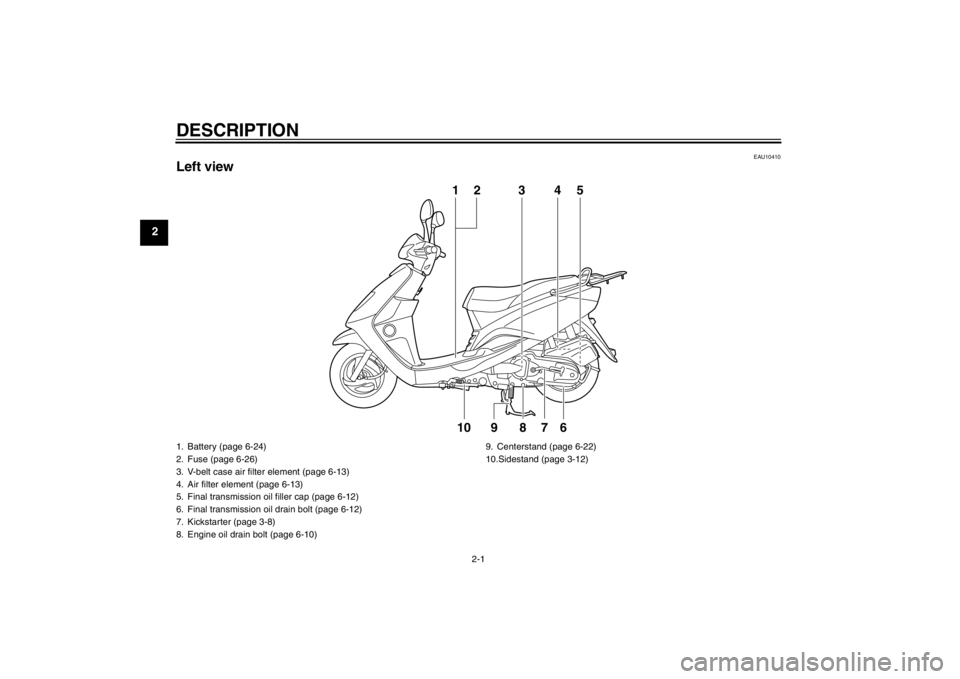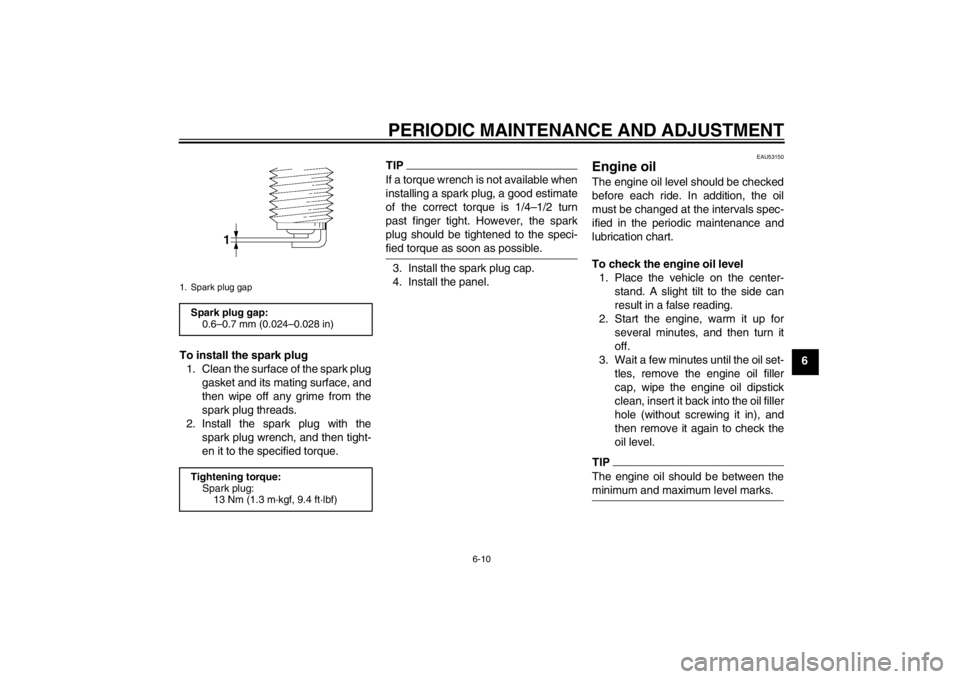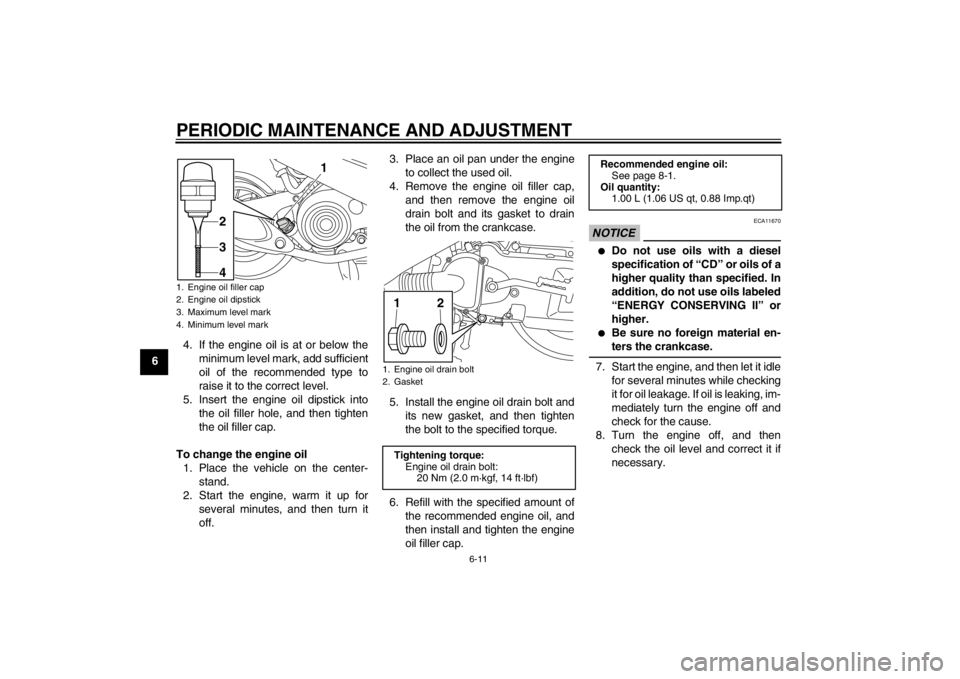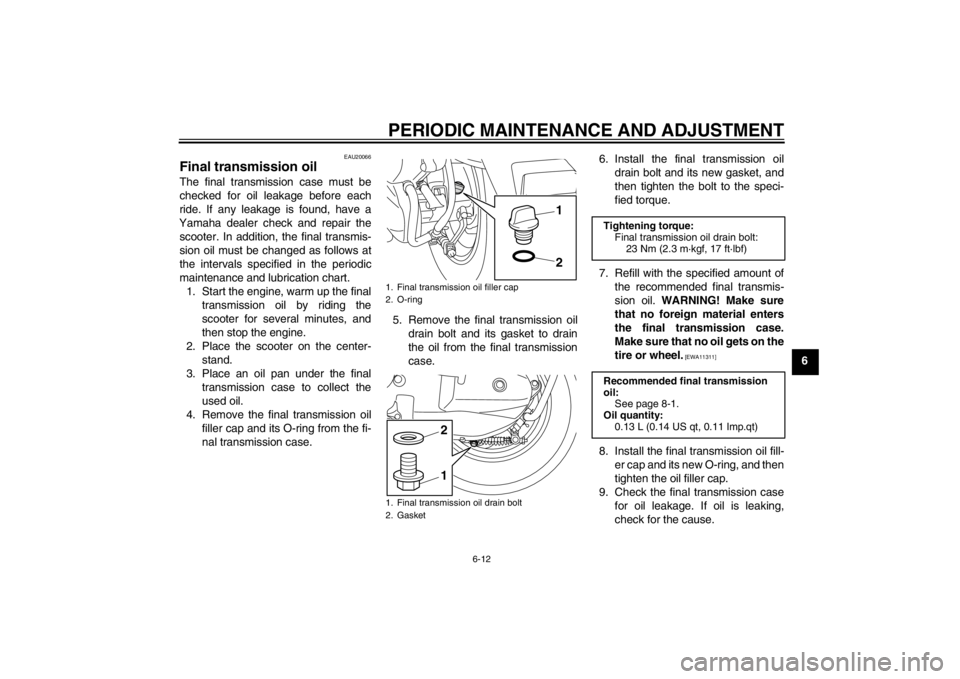engine oil YAMAHA CYGNUS L 2012 Owners Manual
[x] Cancel search | Manufacturer: YAMAHA, Model Year: 2012, Model line: CYGNUS L, Model: YAMAHA CYGNUS L 2012Pages: 76, PDF Size: 1.56 MB
Page 6 of 76

TABLE OF CONTENTSSAFETY INFORMATION ..................1-1
Further safe-riding points ................1-5
DESCRIPTION ..................................2-1
Left view ..........................................2-1
Right view ........................................2-2
Controls and instruments.................2-3
INSTRUMENT AND CONTROL
FUNCTIONS.......................................3-1
Main switch/steering lock ................3-1
Keyhole cover .................................3-2
Indicator lights and warning light ....3-2
Speedometer unit ...........................3-3
Self-diagnosis device ......................3-3
Fuel gauge ......................................3-4
Handlebar switches ........................3-4
Front brake lever ............................3-5
Rear brake lever .............................3-5
Fuel tank cap ..................................3-5
Fuel .................................................3-6
Catalytic converters ........................3-7
Kickstarter .......................................3-8
Seat ................................................3-8
Helmet holders ...............................3-9
Storage compartments ...................3-9
Carrier ...........................................3-11
Luggage hook ...............................3-11
Grab bar .......................................3-11
Sidestand ......................................3-12
Ignition circuit cut-off system ........3-12FOR YOUR SAFETY –
PRE-OPERATION CHECKS............. 4-1
OPERATION AND IMPORTANT
RIDING POINTS................................. 5-1
Starting the engine ......................... 5-1
Starting off ...................................... 5-2
Acceleration and deceleration ........ 5-2
Braking ........................................... 5-2
Tips for reducing fuel
consumption ............................... 5-3
Engine break-in .............................. 5-3
Parking ........................................... 5-4
PERIODIC MAINTENANCE AND
ADJUSTMENT................................... 6-1
Periodic maintenance chart for
the emission control system ....... 6-3
General maintenance and
lubrication chart .......................... 6-4
Removing and installing cowlings
and panels .................................. 6-7
Checking the spark plug ................. 6-9
Engine oil ..................................... 6-10
Final transmission oil .................... 6-12
Air filter and V-belt case air filter
elements ................................... 6-13
Checking the engine idling
speed ........................................ 6-15
Checking the throttle grip free
play ........................................... 6-15Valve clearance ........................... 6-15
Tires ............................................. 6-16
Cast wheels ................................. 6-17
Checking the front brake lever
free play .................................... 6-18
Adjusting the rear brake lever
free play .................................... 6-18
Checking the front brake pads
and rear brake shoes ............... 6-19
Checking the brake fluid level ...... 6-20
Changing the brake fluid .............. 6-21
Checking and lubricating
the cables ................................. 6-21
Checking and lubricating
the throttle grip and cable ......... 6-21
Lubricating the front and
rear brake levers ...................... 6-22
Checking and lubricating the
centerstand and sidestand ....... 6-22
Checking the front fork ................. 6-23
Checking the steering .................. 6-24
Checking the wheel bearings ....... 6-24
Battery ......................................... 6-24
Replacing the fuse ....................... 6-26
Replacing the headlight bulb ....... 6-26
Replacing a front turn signal
light bulb ................................... 6-27
Rear turn signal light and
tail/brake light ........................... 6-28
Replacing the auxiliary light
bulb ........................................... 6-28U1RSE0E0.book Page 1 Tuesday, October 18, 2011 8:56 AM
Page 14 of 76

DESCRIPTION
2-1
2
EAU10410
Left view
1
23
10
9
8
7
64
5
1. Battery (page 6-24)
2. Fuse (page 6-26)
3. V-belt case air filter element (page 6-13)
4. Air filter element (page 6-13)
5. Final transmission oil filler cap (page 6-12)
6. Final transmission oil drain bolt (page 6-12)
7. Kickstarter (page 3-8)
8. Engine oil drain bolt (page 6-10)9. Centerstand (page 6-22)
10.Sidestand (page 3-12)U1RSE0E0.book Page 1 Tuesday, October 18, 2011 8:56 AM
Page 15 of 76

DESCRIPTION
2-2
2
EAU10420
Right view
1
3
2
4
5
9
8
7
6
1. Carrier (page 3-11)
2. Grab bar (page 3-11/5-2)
3. Fuel tank cap (page 3-5)
4. Rear storage compartment (page 3-9)
5. Helmet holder (page 3-9)
6. Front storage compartment (page 3-9)
7. Luggage hook (page 3-11)
8. Spark plug (page 6-9)9. Engine oil filler cap (page 6-10)
U1RSE0E0.book Page 2 Tuesday, October 18, 2011 8:56 AM
Page 30 of 76

FOR YOUR SAFETY – PRE-OPERATION CHECKS
4-1
4
EAU15596
Inspect your vehicle each time you use it to make sure the vehicle is in safe operating condition. Always follow the inspection
and maintenance procedures and schedules described in the Owner’s Manual.
WARNING
EWA11151
Failure to inspect or maintain the vehicle properly increases the possibility of an accident or equipment damage.
Do not operate the vehicle if you find any problem. If a problem cannot be corrected by the procedures provided in
this manual, have the vehicle inspected by a Yamaha dealer.Before using this vehicle, check the following points:
ITEM CHECKS PAGE
Fuel Check fuel level in fuel tank.
Refuel if necessary.
Check fuel line for leakage.3-6
Engine oil Check oil level in engine.
If necessary, add recommended oil to specified level.
Check vehicle for oil leakage.6-10
Final transmission oil Check vehicle for oil leakage. 6-12
Front brake Check operation.
If soft or spongy, have Yamaha dealer bleed hydraulic system.
Check brake pads for wear.
Replace if necessary.
Check fluid level in reservoir.
If necessary, add specified brake fluid to specified level.
Check hydraulic system for leakage.6-19, 6-20
Rear brake Check operation.
Lubricate cable if necessary.
Check lever free play.
Adjust if necessary.6-18, 6-19
U1RSE0E0.book Page 1 Tuesday, October 18, 2011 8:56 AM
Page 35 of 76

OPERATION AND IMPORTANT RIDING POINTS
5-4
5 500–1000 km (300–600 mi)
Avoid prolonged operation above 3/4
throttle. NOTICE: After 1000 km (600
mi) of operation, be sure to change
the engine oil and final transmission
oil, and to clean the oil strainer.
[ECA16501]1000 km (600 mi) and beyond
The vehicle can now be operated nor-
mally.NOTICE
ECA10270
If any engine trouble should occur
during the engine break-in period,
immediately have a Yamaha dealer
check the vehicle.
EAU17213
Parking When parking, stop the engine, and
then remove the key from the main
switch.
WARNING
EWA10311
●
Since the engine and exhaust
system can become very hot,
park in a place where pedestri-
ans or children are not likely to
touch them and be burned.
●
Do not park on a slope or on soft
ground, otherwise the vehicle
may overturn, increasing the
risk of a fuel leak and fire.
●
Do not park near grass or other
flammable materials which
might catch fire.
U1RSE0E0.book Page 4 Tuesday, October 18, 2011 8:56 AM
Page 40 of 76

PERIODIC MAINTENANCE AND ADJUSTMENT
6-5
6
9*Steering bearings Check bearing play and steering
for roughness.√√√√√
Lubricate with lithium-soap-based
grease.Every 24000 km (14000 mi)
10*Chassis fasteners Make sure that all nuts, bolts and
screws are properly tightened.√√√√√
11Front brake lever
pivot shaft Lubricate with silicone grease.√√√√√
12Rear brake lever
pivot shaft Lubricate with lithium-soap-based
grease.√√√√√
13Sidestand, center-
stand Check operation.
Lubricate with lithium-soap-based
grease.√√√√√
14*Sidestand switch Check operation.√√√√√√
15*Front fork Check operation and for oil leak-
age.√√√√
16*Shock absorber as-
sembly Check operation and shock ab-
sorber for oil leakage.√√√√
17 Engine oil Change. (See page 6-10.)
Check oil level and vehicle for oil
leakage.√Every 2000 km (1200 mi)
18*Engine oil strainer Clean.√
19Final transmission
oil Check vehicle for oil leakage.
Change.√√√√√√
20*V- b e l t Replace. Every 12000 km (7000 mi) NO. ITEM CHECK OR MAINTENANCE JOBODOMETER READING
ANNUAL
CHECK 1000 km
(600 mi)6000 km
(3500 mi)12000 km
(7000 mi)18000 km
(10500 mi)24000 km
(14000 mi)
U1RSE0E0.book Page 5 Tuesday, October 18, 2011 8:56 AM
Page 45 of 76

PERIODIC MAINTENANCE AND ADJUSTMENT
6-10
6 To install the spark plug
1. Clean the surface of the spark plug
gasket and its mating surface, and
then wipe off any grime from the
spark plug threads.
2. Install the spark plug with the
spark plug wrench, and then tight-
en it to the specified torque.
TIPIf a torque wrench is not available when
installing a spark plug, a good estimate
of the correct torque is 1/4–1/2 turn
past finger tight. However, the spark
plug should be tightened to the speci-
fied torque as soon as possible.3. Install the spark plug cap.
4. Install the panel.
EAU53150
Engine oil The engine oil level should be checked
before each ride. In addition, the oil
must be changed at the intervals spec-
ified in the periodic maintenance and
lubrication chart.
To check the engine oil level
1. Place the vehicle on the center-
stand. A slight tilt to the side can
result in a false reading.
2. Start the engine, warm it up for
several minutes, and then turn it
off.
3. Wait a few minutes until the oil set-
tles, remove the engine oil filler
cap, wipe the engine oil dipstick
clean, insert it back into the oil filler
hole (without screwing it in), and
then remove it again to check the
oil level.TIPThe engine oil should be between the
minimum and maximum level marks.
1. Spark plug gapSpark plug gap:
0.6–0.7 mm (0.024–0.028 in)
Tightening torque:
Spark plug:
13 Nm (1.3 m·kgf, 9.4 ft·lbf)
U1RSE0E0.book Page 10 Tuesday, October 18, 2011 8:56 AM
Page 46 of 76

PERIODIC MAINTENANCE AND ADJUSTMENT
6-11
64. If the engine oil is at or below the
minimum level mark, add sufficient
oil of the recommended type to
raise it to the correct level.
5. Insert the engine oil dipstick into
the oil filler hole, and then tighten
the oil filler cap.
To change the engine oil
1. Place the vehicle on the center-
stand.
2. Start the engine, warm it up for
several minutes, and then turn it
off.3. Place an oil pan under the engine
to collect the used oil.
4. Remove the engine oil filler cap,
and then remove the engine oil
drain bolt and its gasket to drain
the oil from the crankcase.
5. Install the engine oil drain bolt and
its new gasket, and then tighten
the bolt to the specified torque.
6. Refill with the specified amount of
the recommended engine oil, and
then install and tighten the engine
oil filler cap.
NOTICE
ECA11670
●
Do not use oils with a diesel
specification of “CD” or oils of a
higher quality than specified. In
addition, do not use oils labeled
“ENERGY CONSERVING II” or
higher.
●
Be sure no foreign material en-
ters the crankcase.
7. Start the engine, and then let it idle
for several minutes while checking
it for oil leakage. If oil is leaking, im-
mediately turn the engine off and
check for the cause.
8. Turn the engine off, and then
check the oil level and correct it if
necessary.
1. Engine oil filler cap
2. Engine oil dipstick
3. Maximum level mark
4. Minimum level mark
32
1
4
1. Engine oil drain bolt
2. GasketTightening torque:
Engine oil drain bolt:
20 Nm (2.0 m·kgf, 14 ft·lbf)1
2
Recommended engine oil:
See page 8-1.
Oil quantity:
1.00 L (1.06 US qt, 0.88 Imp.qt)
U1RSE0E0.book Page 11 Tuesday, October 18, 2011 8:56 AM
Page 47 of 76

PERIODIC MAINTENANCE AND ADJUSTMENT
6-12
6
EAU20066
Final transmission oil The final transmission case must be
checked for oil leakage before each
ride. If any leakage is found, have a
Yamaha dealer check and repair the
scooter. In addition, the final transmis-
sion oil must be changed as follows at
the intervals specified in the periodic
maintenance and lubrication chart.
1. Start the engine, warm up the final
transmission oil by riding the
scooter for several minutes, and
then stop the engine.
2. Place the scooter on the center-
stand.
3. Place an oil pan under the final
transmission case to collect the
used oil.
4. Remove the final transmission oil
filler cap and its O-ring from the fi-
nal transmission case.5. Remove the final transmission oil
drain bolt and its gasket to drain
the oil from the final transmission
case.6. Install the final transmission oil
drain bolt and its new gasket, and
then tighten the bolt to the speci-
fied torque.
7. Refill with the specified amount of
the recommended final transmis-
sion oil. WARNING! Make sure
that no foreign material enters
the final transmission case.
Make sure that no oil gets on the
tire or wheel.
[EWA11311]
8. Install the final transmission oil fill-
er cap and its new O-ring, and then
tighten the oil filler cap.
9. Check the final transmission case
for oil leakage. If oil is leaking,
check for the cause.
1. Final transmission oil filler cap
2. O-ring
1. Final transmission oil drain bolt
2. Gasket
1
2
12
Tightening torque:
Final transmission oil drain bolt:
23 Nm (2.3 m·kgf, 17 ft·lbf)
Recommended final transmission
oil:
See page 8-1.
Oil quantity:
0.13 L (0.14 US qt, 0.11 Imp.qt)
U1RSE0E0.book Page 12 Tuesday, October 18, 2011 8:56 AM
Page 56 of 76

PERIODIC MAINTENANCE AND ADJUSTMENT
6-21
6
EAU22721
Changing the brake fluid Have a Yamaha dealer change the
brake fluid at the intervals specified in
the TIP after the periodic maintenance
and lubrication chart. In addition, have
the oil seals of the brake master cylin-
der and caliper as well as the brake
hose replaced at the intervals listed be-
low or whenever they are damaged or
leaking.●
Oil seals: Replace every two
years.
●
Brake hose: Replace every four
years.
EAU23095
Checking and lubricating the
cables The operation of all control cables and
the condition of the cables should be
checked before each ride, and the ca-
bles and cable ends should be lubricat-
ed if necessary. If a cable is damaged
or does not move smoothly, have a
Yamaha dealer check or replace it.
WARNING! Damage to the outer
housing of cables may result in in-
ternal rusting and cause interfer-
ence with cable movement. Replace
damaged cables as soon as possi-
ble to prevent unsafe conditions.[EWA10711]EAU23114
Checking and lubricating the
throttle grip and cable The operation of the throttle grip should
be checked before each ride. In addi-
tion, the cable should be lubricated by a
Yamaha dealer at the intervals speci-
fied in the periodic maintenance chart.
The throttle cable is equipped with a
rubber cover. Make sure that the cover
is securely installed. Even though the
cover is installed correctly, it does not
completely protect the cable from water
entry. Therefore, use care not to pour
water directly onto the cover or cable
when washing the vehicle. If the cable
or cover becomes dirty, wipe clean with
a moist cloth.
Recommended lubricant:
Yamaha Chain and Cable Lube or
engine oil
U1RSE0E0.book Page 21 Tuesday, October 18, 2011 8:56 AM